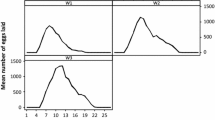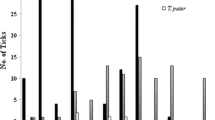Abstract
Hyalomma franchinii is a three-host tick with one life cycle per year under natural conditions. The immature stages of Hy. franchinii parasitize lizards and, less commonly, rodents. Adult hosts are camels, cattle, sheep and donkeys. Immature stages are found on lizards all year around, having been recorded on Acanthodactylus boskianus, Acanthodactylus schreiberi, Acanthodactylus scutellatus and Agama mutabilis according to data summarised by Apanaskevich et al. (2008). Adults appear to be most common during the cooler months of the year. Observations in Egypt (July and August) mentioned a duration of egg development of about 25 days, and a duration of larval moult of about 14–16 days (recorded in September–October).
Access provided by CONRICYT-eBooks. Download chapter PDF
Similar content being viewed by others
Life Cycle and Host Preferences
Hyalomma franchinii is a three-host tick with one life cycle per year under natural conditions (Hoogstraal and Kaiser 1958b). The immature stages of Hy. franchinii parasitize lizards and, less commonly, rodents. Adult hosts are camels, cattle, sheep and donkeys. Immature stages are found on lizards all year around, having been recorded on Acanthodactylus boskianus, Acanthodactylus schreiberi, A. scutellatus and Agama mutabilis according to data summarized by Apanaskevich et al. (2008). Adults appear to be most common during the cooler months of the year. Observations in Egypt (July and August) mentioned a duration of egg development of about 25 days, and a duration of larval moult of about 14–16 days (recorded in September–October).
Ecology
Hyalomma franchinii has a Mediterranean distribution and is adapted to dry and warm environmental conditions. Its distribution area is typically desert and it has not been recorded in areas with more than 10 or 20 l of rainfall/m2 per year. However, it can be relatively abundant near watering points. The immatures are endophilic and are commonly found in the burrows of the lizards. Some observations published by Morel (2003) state that the adults can be found at the entry point of the lizard’s shelter and are exophilic.
Distribution
The known distribution of Hy. franchinii is restricted to the eastern part of the Mediterranean subregion of the Palaearctic zoogeographic region in Africa (Egypt, Libya, Tunisia) and Asia (Israel) (Hoogstraal 1956; Hoogstraal and Kaiser 1958a, b, 1960; Cwilich and Hadani 1962; Bouattour et al. 1999; Apanaskevich et al. 2008).
Vectorial Capacity and Pathogen Burden
The relationships between disease inducing agents and Hy. franchinii have not been investigated. It is common in areas where protozoa of the genus Theileria circulate in nature, but its role in the circulation of these agents has been never tested either under natural or laboratory conditions.
References
Apanaskevich D, Santos-Silva MM, Horak IG (2008) The genus Hyalomma Koch, 1844. IV. Redescription of all parasitic stages of H. (Euhyalomma) lusitanicum Koch, 1844 and the adults of H. (E.) franchinii Tonelli Rondelli, 1932 (Acari: Ixodidae) with a first description of its immature stages. Folia Parasitol 55:61–74
Bouattour A, Darghouth MA, Daoud A (1999) Distribution and ecology of ticks (Acari: Ixodidae) infesting livestock in Tunisia: an overview of eight years field collections. Parassitologia 41:5–10
Cwilich R, Hadani A (1962) The identification of the tick Hyalomma franchinii, Tonelli-Rondelli, 1932. Refu Vet 19:178–180
Hoogstraal H (1956) African Ixodoidea. I. Ticks of the Sudan (with special reference to Equatoria Province and with preliminary reviews of the genera Boophilus, Margaropus, and Hyalomma). Department of the Navy, Washington DC, 1101 pp
Hoogstraal H, Kaiser MN (1958a) Observations on Egyptian Hyalomma ticks (Ixodoidea, Ixodidae). I. Parasitism of lizards by nymphs. Ann Entomol Soc Am 51:7–12
Hoogstraal H, Kaiser MN (1958b) Observations on Egyptian Hyalomma ticks (Ixodoidea, Ixodidae). 4. Identity, distribution, and hosts of H. franchinii Tonelli-Rondelli (new combination). Systematic status of H. tunesiacum Sc. & Sc. and its subspecies. Ann Entomol Soc Am 51:397–400
Hoogstraal H, Kaiser MN (1960) Observations on ticks (Ixodoidea) of Libya. Ann Entomol Soc Am 53:445–457
Morel PC (2003) Les tiques d’Afrique et du Bassin méditerranéen (1965–1995). CIRAD-EMVT, 1342 pp
Author information
Authors and Affiliations
Corresponding author
Editor information
Editors and Affiliations
Rights and permissions
Copyright information
© 2017 Springer International Publishing AG, part of Springer Nature
About this chapter
Cite this chapter
Estrada-Peña, A. (2017). Hyalomma franchinii Tonelli-Rondelli, 1932. In: Estrada-Peña, A., Mihalca, A., Petney, T. (eds) Ticks of Europe and North Africa. Springer, Cham. https://doi.org/10.1007/978-3-319-63760-0_73
Download citation
DOI: https://doi.org/10.1007/978-3-319-63760-0_73
Published:
Publisher Name: Springer, Cham
Print ISBN: 978-3-319-63759-4
Online ISBN: 978-3-319-63760-0
eBook Packages: Biomedical and Life SciencesBiomedical and Life Sciences (R0)




